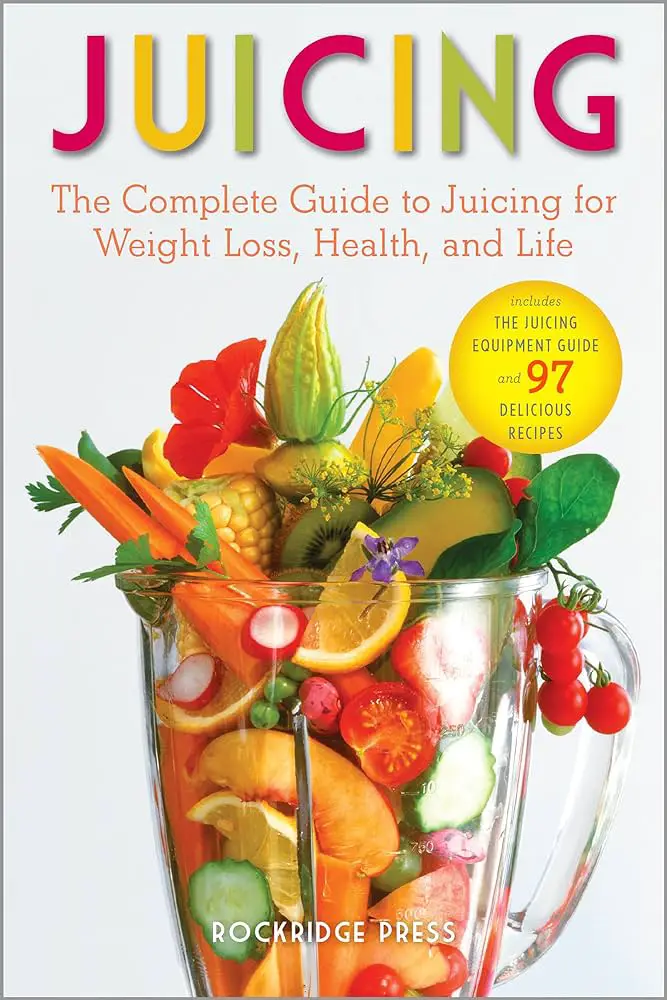Ad Blocker Detected
Our website is made possible by displaying online advertisements to our visitors. Please consider supporting us by disabling your ad blocker.
Are you looking to shed those extra pounds and improve your overall health? Look no further! “The Ultimate Guide to Juicing for Weight Loss” is here to help you on your journey towards a healthier lifestyle. This comprehensive guide will provide you with everything you need to know about juicing, its benefits for weight loss, and how to get started. Say goodbye to crash diets and hello to a delicious and refreshing way to reach your fitness goals. Get ready to revitalize your body and achieve the weight loss results you’ve always dreamed of.

This image is property of Amazon.com.
Benefits of Juicing for Weight Loss
Increased nutrient intake
Juicing is a fantastic way to increase your nutrient intake, as it allows you to consume a higher quantity of fruits and vegetables in a concentrated form. By juicing these ingredients, you can extract all the essential vitamins, minerals, and antioxidants from them, promoting overall health and well-being. This boost in nutrient intake can also support weight loss efforts by providing your body with the necessary nutrition it needs to function optimally.
Reduced calorie intake
One of the key benefits of juicing for weight loss is the reduction in calorie intake. When you replace a meal or snack with a nutritious juice, you are consuming significantly fewer calories than you would from a traditional solid meal. This calorie deficit can promote weight loss by creating an energy imbalance, forcing your body to tap into its fat stores for fuel. Additionally, the high water content in juices can help you feel fuller for longer, reducing the likelihood of overeating and snacking on unhealthy foods.
Improved digestion
Juicing can also provide relief to those struggling with digestive issues. Juices are naturally rich in dietary fiber, which helps to promote healthy digestion and prevent constipation. By removing the fibrous pulp, juicing allows your body to easily absorb and assimilate the nutrients, supporting the digestive process. The enzymes present in fresh juices can also help break down food more efficiently, ensuring you get the most out of the nutrients you consume.
Detoxification and cleansing
Another significant benefit of juicing for weight loss is its detoxifying and cleansing effect on the body. By consuming a variety of fruits and vegetables known for their detoxifying properties, you can help eliminate toxins and waste products that may be hampering your weight loss efforts. Moreover, the high water content in juices can flush out the system, hydrate the body, and promote healthy kidney function. This detoxification process is essential for maintaining overall health and aiding in weight loss.
Choosing the Right Juicer
Centrifugal juicers
Centrifugal juicers are the most common type of juicer available on the market. They work by using rapidly spinning blades to extract juice from fruits and vegetables. These juicers are known for their speed and convenience, making them a popular choice for beginners or those with busy lifestyles. However, it is important to note that centrifugal juicers can produce a slightly less nutritious juice due to the heat generated during the juicing process, which may affect some of the heat-sensitive nutrients.
Masticating juicers
Masticating juicers, also known as slow juicers or cold press juicers, operate at a lower speed compared to centrifugal models. They use an auger to slowly crush and squeeze the juice out of the produce, resulting in a higher yield and less oxidation. Masticating juicers are preferred by many juicing enthusiasts for their ability to preserve more nutrients and produce a juice that has a longer shelf life. However, they can be more expensive and require more time and effort to use.
Citrus juicers
If you primarily enjoy citrus fruits like oranges, lemons, and grapefruits, a citrus juicer may be the best option for you. These juicers are specifically designed to extract juice from citruses efficiently. They are typically compact and easy to use, making them a great choice for anyone looking to incorporate more citrus-based juices into their weight loss plan.
Twin gear juicers
Twin gear juicers are often considered the top-of-the-line juicers due to their superior juice quality and nutrient preservation. These juicers use two interlocking gears to crush and press the produce, resulting in the highest yield and the least amount of oxidation. Twin gear juicers are ideal for serious juicers who are committed to getting the most out of their ingredients and are willing to invest in a high-quality juicing machine.

This image is property of Amazon.com.
Selecting the Best Ingredients
Leafy greens
Leafy greens such as kale, spinach, and Swiss chard are excellent additions to your weight loss juicing recipes. These greens are low in calories and high in essential nutrients like vitamins A, C, and K, as well as minerals like calcium and iron. They also contain fiber, which can help you feel fuller for longer and support healthy digestion. Adding a handful of leafy greens to your juices not only enhances the nutritional value but also adds a refreshing flavor.
Cruciferous vegetables
Cruciferous vegetables like broccoli, cauliflower, and cabbage are packed with health benefits and can be great choices for weight loss juicing. These vegetables are known for their high fiber content, which aids in digestion and helps regulate blood sugar levels. Additionally, they contain compounds called glucosinolates, which have been linked to potential anti-cancer properties. Including cruciferous vegetables in your juices can add a delicious depth of flavor while boosting the nutrient content.
Fruits
Fruits are a natural source of sweetness in juices, making them an enjoyable addition to any weight loss juicing regime. However, it’s important to choose fruits wisely, as some are higher in sugar than others. Opt for fruits with a lower glycemic index such as berries, green apples, and citrus fruits. These fruits provide a burst of flavor and are rich in antioxidants and vitamins. Including a variety of fruits in your juices not only enhances the taste but also adds nutritional value.
Herbs and spices
Incorporating herbs and spices into your weight loss juices can provide both flavor and additional health benefits. Herbs like parsley and cilantro are known for their detoxifying properties and can help cleanse the body. Spices like ginger and turmeric have anti-inflammatory effects and promote healthy digestion. Experimenting with different herbs and spices can add depth and complexity to your juices while maximizing their nutritional value.
Healthy fats and proteins
While fruits and vegetables should form the bulk of your weight loss juices, it is essential to include a small amount of healthy fats and proteins to make your juices more balanced and filling. Adding ingredients like avocado, chia seeds, or a scoop of plant-based protein powder can help provide sustained energy and promote satiety. These additions not only enhance the texture and taste of your juices but also contribute to your overall nutrient intake.
Creating Balanced and Nutritious Juices
Balancing sugar content
When creating weight loss juices, it is important to be mindful of the sugar content. While fruits are a natural source of sugar, it is essential to balance the sweetness with other ingredients and prioritize fruits with a lower glycemic index. Combining low-sugar fruits with plenty of vegetables, leafy greens, and herbs can help minimize the impact on blood sugar levels and prevent unnecessary spikes. This balanced approach ensures that your juices are both delicious and supportive of your weight loss goals.
Incorporating fiber
Although juicing removes most of the fiber from the produce, it is still beneficial to include some fiber in your weight loss juices. This can be achieved by adding ingredients like chia seeds, flaxseeds, or even a small amount of pulp back into the juice. Including fiber helps slow down digestion, promotes satiety, and supports healthy bowel movements. Aim to strike a balance between removing the pulp for easier digestion and incorporating some fiber to maximize the nutritional value of your juices.
Adding protein and healthy fats
To make your weight loss juices more balanced and satiating, consider adding a small amount of protein and healthy fats. This can be done by incorporating ingredients like almond butter, Greek yogurt, or a scoop of protein powder. Protein helps build and repair tissues while also promoting satiety. Healthy fats provide essential nutrients and help slow down the digestion process, keeping you feeling fuller for longer. Including these components in your juices ensures that you are receiving a well-rounded and nourishing meal replacement.
Including superfoods
Adding superfoods to your weight loss juices can take their nutritional value to the next level. Superfoods, such as spirulina, wheatgrass, or maca powder, are rich in essential vitamins, minerals, and antioxidants that can support overall health and well-being. These ingredients can provide an extra boost of nutrients, promote detoxification, and enhance the effectiveness of your weight loss efforts. Experiment with different superfoods to discover your favorites and incorporate them into your juices for a nutritional powerhouse.

This image is property of Amazon.com.
Juicing Recipes for Weight Loss
Green juice recipe
Ingredients:
- 2 cups spinach
- 1 cucumber
- 2 green apples
- 1 lemon
- 1-inch piece of ginger
Instructions:
- Wash all the ingredients thoroughly.
- Cut the cucumber and green apples into smaller pieces for easier juicing.
- Juice all the ingredients together using your preferred juicer.
- Stir the juice well before enjoying.
- Drink immediately for maximum freshness and nutrient content.
Detoxifying juice recipe
Ingredients:
- 1 beetroot
- 2 carrots
- 1 celery stalk
- 1 green apple
- 1 lemon
- 1-inch piece of turmeric root
Instructions:
- Prepare the ingredients by washing and cutting them into smaller pieces.
- Juice all the ingredients together until you have a vibrant and smooth juice.
- Gently stir the juice to ensure all the flavors blend well.
- Consume the juice immediately for optimal taste and detoxifying benefits.
Citrus blast recipe
Ingredients:
- 3 oranges
- 2 grapefruits
- 1 lime
- 1 lemon
Instructions:
- Peel the oranges, grapefruits, lime, and lemon, removing any seeds.
- Juice the citrus fruits together, making sure to extract all the juice.
- Give the juice a good stir to combine the flavors.
- Serve and enjoy the refreshing and tangy citrus blast.
Berry blast recipe
Ingredients:
- 1 cup mixed berries (strawberries, blueberries, raspberries)
- 1 green apple
- 1 cup spinach
- 1 tablespoon chia seeds
Instructions:
- Wash the berries, green apple, and spinach thoroughly.
- Cut the green apple into small pieces for easier juicing.
- Juice all the ingredients together until you have a vibrant, berry-packed juice.
- Add chia seeds to the juice and give it a good stir.
- Allow the chia seeds to soak for a few minutes before enjoying the fruity and nutritious blast.
Cleansing vegetable juice recipe
Ingredients:
- 2 carrots
- 1 cucumber
- 1 beetroot
- 2 celery stalks
- 1 handful of parsley
Instructions:
- Prepare the ingredients by washing and cutting them into smaller pieces.
- Juice all the vegetables together, making sure to extract all the juice.
- Give the juice a gentle stir to combine the flavors.
- Pour into a glass and savor the refreshing and cleansing vegetable juice.
Juicing Tips for Weight Loss
Start with small portions
When incorporating juicing into your weight loss plan, it’s important to start with small portions and gradually increase the amount as your body adjusts. Drinking too much juice at once can overwhelm your digestive system and potentially lead to discomfort. Begin with a small serving, such as 8-12 ounces, and listen to your body’s response. If it feels manageable, gradually increase the amount as necessary.
Drink juice immediately
To maximize the nutritional benefits of your weight loss juices, it is best to drink them immediately after juicing. Exposure to air and light can lead to oxidation and nutrient loss, so consuming the juice soon after preparation ensures you’re getting the most out of your ingredients. If you do need to store your juice for later consumption, place it in an airtight container and refrigerate it for no more than 24 hours.
Include variety in your juices
To prevent boredom and ensure a diverse nutrient intake, it is important to include a variety of fruits, vegetables, herbs, and spices in your weight loss juices. This variety not only enhances the taste but also provides a wide range of essential vitamins, minerals, and antioxidants. Experiment with different combinations to discover your favorite flavor profiles and incorporate seasonal produce to add freshness and variety to your juices.
Stay hydrated
While juicing can help hydrate your body with its high water content, it is still important to drink plenty of water throughout the day. Water supports digestion, nutrient absorption, and overall health. Aim to drink at least 8 glasses of water per day, in addition to your weight loss juices. Staying properly hydrated will help you feel energized, support healthy bodily functions, and aid in weight loss.
Combine juicing with a balanced diet
Juicing should be seen as a complement to a balanced diet rather than a complete meal replacement. While weight loss juices can be a nutritious option, it is important to also include whole foods like lean proteins, whole grains, and healthy fats in your diet. These foods provide essential nutrients that may be missing from your juice and help create a well-rounded eating plan. Consult a registered dietitian or nutritionist to develop a personalized meal plan that suits your specific dietary needs.
Monitor your calorie intake
Even though weight loss juices can be lower in calories compared to solid meals, it is crucial to monitor your overall calorie intake to ensure a healthy weight loss rate. While juicing can be a useful tool for weight loss, relying solely on juices without considering portion sizes and caloric balance may lead to consuming more calories than your body needs. Keep track of the ingredients you use in your juices and pay attention to your overall calorie consumption to support sustainable weight loss.

This image is property of Amazon.com.
Potential Risks and Precautions
Risk of nutrient deficiencies
While juicing can be an excellent way to increase your nutrient intake, it is important to note that juicing removes some of the fiber and macronutrients found in whole fruits and vegetables. This might result in a lower intake of certain nutrients, such as dietary fiber and protein. To mitigate this risk, it is essential to incorporate a variety of whole foods and to consult with a healthcare professional or registered dietitian who can guide you on meeting your specific nutritional needs.
Risk of consuming too much sugar
Fruits are naturally high in sugar, and when juiced, the sugar content can become concentrated. While fruits do provide essential nutrients and fiber, it is important to be mindful of the total sugar content in your weight loss juices, especially if you have diabetes or are following a low-sugar diet. Opt for low-sugar fruits and balance them with vegetables, leafy greens, and herbs to minimize the impact on blood sugar levels.
Precautions for certain medical conditions
If you have any underlying medical conditions or are taking medications, it is important to consult with your healthcare provider before starting a weight loss juicing plan. Certain medical conditions, such as diabetes, kidney disease, or gastrointestinal disorders, may require specific dietary modifications that should be considered when incorporating juicing into your routine. Your healthcare provider can guide you on any potential risks or adjustments needed to ensure your juicing plan is safe and suitable for your individual needs.
Potential for weight regain
While juicing can be a beneficial component of a weight loss plan, it is important to recognize that sustainable weight loss requires long-term lifestyle changes. Relying solely on juicing for an extended period may result in weight regain once you reintroduce solid foods. It is crucial to transition gradually from juicing to a balanced and nutritious diet, incorporating whole foods and maintaining portion control. Focus on making healthy eating habits a sustainable part of your lifestyle for long-term weight management.
Incorporating Juicing into Your Weight Loss Plan
Setting realistic goals
Before incorporating juicing into your weight loss plan, it is essential to set realistic goals. Understand that weight loss is a gradual process and it is important to aim for a healthy rate of weight loss, typically 1-2 pounds per week. Setting realistic goals helps promote long-term success and prevents unnecessary frustration. Track your progress, but remember that weight loss is not the only indicator of success – focus on how you feel and your overall well-being as well.
Developing a juicing schedule
To make juicing a consistent part of your weight loss plan, it can be helpful to develop a juicing schedule. Determine how many meals or snacks you want to replace with juices and plan accordingly. Some people prefer to have one or two juices a day, while others may choose to have a juice as a snack or a meal replacement. Find a schedule that works best for your lifestyle and makes it easier for you to stick to your weight loss goals.
Creating a healthy meal plan
Incorporating juicing into your weight loss plan does not mean neglecting other aspects of nutrition. Create a healthy meal plan that includes a balance of whole foods, lean proteins, healthy fats, and complex carbohydrates. This will ensure that you are getting a wide range of nutrients and supporting your overall health and well-being. Consult a registered dietitian or nutritionist for personalized guidance on creating a balanced meal plan that aligns with your weight loss goals.
Including physical activity
Physical activity is an important component of any weight loss plan. Alongside juicing, incorporate regular exercise into your routine to increase calorie burn and support overall fitness. Choose activities that you enjoy, whether it’s walking, jogging, dancing, or joining a fitness class, and aim for at least 150 minutes of moderate-intensity exercise per week. The combination of juicing and physical activity will help you achieve your weight loss goals more effectively.
Monitoring progress
Tracking your progress is essential to stay motivated and make adjustments to your weight loss plan as needed. Keep a journal or use a mobile app to record your daily food intake, juice recipes, exercise routine, and any other relevant information. Monitoring your progress can help you identify patterns, track your caloric intake, and identify areas for improvement. Celebrate your achievements along the way, no matter how small, as they are stepping stones towards achieving your long-term weight loss goals.

This image is property of images.booksense.com.
Long-Term Weight Management Strategies
Maintaining a balanced diet
Once you have reached your weight loss goals, it is important to transition from a weight loss plan to a long-term weight management strategy. Adopting a balanced diet that incorporates a variety of fruits, vegetables, whole grains, lean proteins, and healthy fats is key to maintaining your weight loss success. Focus on portion control, mindful eating, and making nutritious choices to prevent weight regain and support overall health.
Adopting a healthy lifestyle
In addition to maintaining a balanced diet, it is important to adopt a healthy lifestyle to support long-term weight management. This includes regular physical activity, managing stress levels, getting enough sleep, and avoiding harmful habits such as smoking or excessive alcohol consumption. A holistic approach to overall wellness will not only help you maintain your weight but also support a healthier and more fulfilling life.
Monitoring portion sizes
Even when maintaining a balanced diet, portion control plays a crucial role in keeping weight in check. It can be easy to overeat, even with healthy foods, so pay attention to portion sizes and practice mindful eating. Use measuring cups or a food scale to become familiar with appropriate serving sizes, and listen to your body’s hunger and fullness cues. Being mindful of portion sizes will help prevent overeating and support long-term weight management.
Finding a sustainable exercise routine
Regular physical activity is important not only for weight loss but also for weight management. Find an exercise routine that you enjoy and can sustain in the long term. Whether it’s going for a daily walk, attending fitness classes, or engaging in team sports, find activities that keep you motivated and make them a part of your regular routine. Aim for a combination of cardiovascular exercise, strength training, and flexibility exercises to promote overall fitness and support weight management.
Managing stress and emotions
Stress and emotions can significantly impact our eating habits and weight management efforts. It is essential to practice stress management techniques such as meditation, deep breathing, or engaging in hobbies that bring you joy. Additionally, seek emotional support from friends, family, or professionals when needed. By managing stress and emotions effectively, you can avoid emotional eating and maintain a healthier relationship with food, contributing to long-term weight management success.
Can Juicing for Weight Loss be Effective for Couples?
Juicing for weight loss can be an effective strategy for couples looking to get healthier together. By incorporating the ultimate weight loss couples plan, they can share recipes, motivate each other, and enjoy the benefits of their combined efforts. Juicing can be a fun and bonding way to reach their fitness goals.
Conclusion
Juicing can be a valuable tool for weight loss, providing a convenient, nutrient-dense, and delicious way to support your health and fitness goals. From boosting nutrient intake and reducing calorie consumption to improving digestion and aiding in detoxification, the benefits of juicing for weight loss are abundant. By choosing the right juicer, selecting the best ingredients, creating balanced and nutritious juices, and following juicing tips, you can make the most out of your weight loss juicing journey.
Remember to set realistic goals, develop a juicing schedule, and incorporate physical activity into your routine. Monitor your progress, make necessary adjustments, and prioritize long-term weight management strategies such as maintaining a balanced diet and adopting a healthy lifestyle. With proper planning, dedication, and the right mindset, juicing can serve as a powerful tool to help you achieve and maintain your weight loss goals while ensuring overall health and well-being.


